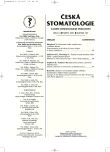Methods of Vital Pulp Therapy – Direct Pulp Capping
Vitální metody ošetření zubní dřeně – přímé překrytí dřeně
Autoři se zabývají v dlouhodobé klinické a histologické studii historií, vývojem a současným stavem této ošetřovací metody. Studie je dokumentována vlastními histologickými preparáty lidských zubů. Celkem bylo histologicky zpracováno 539 lidských zubů rozdělených do 3 skupin podle sledovaných kritérií.
Na několika dlouhodobě sledovaných klinických případech poukazují na možné komplikace, které dokumentují na rentgenových snímcích a rovněž na náhodně získaných histologických preparátech. Na základě svých dosavadních zkušeností závěrem shrnují indikace a v současné době vhodný způsob provedení přímého překrytí pulpy, který zaručuje co největší úspěšnost.
Klíčová slova:
přímé překrytí dřeně - hydroxid kalcia - dentinový můstek - obliterace kořenového kanálku
Authors:
E. Záhlavová; J. Netolický
Authors‘ workplace:
Stomatologická klinika LF UK a FN, Plzeň
přednosta doc. MUDr. A. Zicha, CSc.
Published in:
Česká stomatologie / Praktické zubní lékařství, ročník 107, 2007, 4, s. 89-93
Overview
In this long-term, clinical study, the authors are concerned with the history, development and contemporary possibilities of vital pulp therapy. Our department has been for more than thirty years engaged in following of repair processes in the dental pulp, as well as results after the treatment of injured dental pulp during direct pulp capping. Clinical observation was complemented by experimental study on human teeth.
Initial hypothesis of successful direct pulp capping:
Biologically high-quality dental pulp can be repaired
Capping material should support repair processes in the dental pulp
Cavity must be closed with hermetic filling without any leakage
Long-term observation of histological sections of 539 extracted human teeth was divided into three groups. All teeth were decalcified in the electrolytic way. Then they were processed by the celoidin technique and coloured with H&E stain.
Our long-term clinical observation and literary sources confirm that for successful direct pulp capping it is dominant:
1. Valid diagnosis of injured pulp biological state (young, up to 30 years, tooth without any clinical symptoms, vital, without possible iatrogenic changes, small perforation in intact dentine, with slight bleeding of clearly red blood, aseptic working procedure).
2. For common practice we recommended combined salicylic cement with Ca(OH)2 (Dycal, Dentsply DeTray) for capping, especially for its easy application in small portions and good biologic features.
3. Exact making of resin composite filling with high-quality bonding system is necessary.
It is necessary to indicate and perform direct pulp capping advisedly and only in sporadic cases. Early and welldone root canal treatment has generally better prognosis.
Key words:
direct pulp capping - calcium hydroxide cement - dentine bridge - root canal obliteration
Labels
Maxillofacial surgery Orthodontics Dental medicineArticle was published in
Czech Dental Journal

2007 Issue 4
- What Effect Can Be Expected from Limosilactobacillus reuteri in Mucositis and Peri-Implantitis?
- The Importance of Limosilactobacillus reuteri in Administration to Diabetics with Gingivitis
Most read in this issue
- Methods of Vital Pulp Therapy – Direct Pulp Capping
- The Use of FRC Retention Splint in Orthodontic Patient in Magnetic Resonance Examination
- Adhesive Systems in Prevention of Dental Caries
- Determination of the Risk of Caries Origin in Early Childhood
